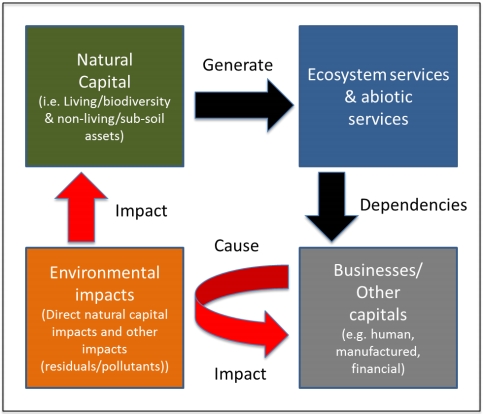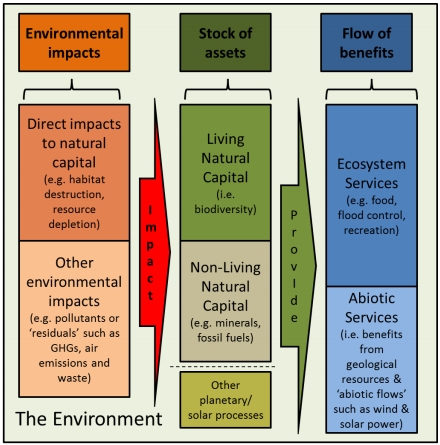
Inter-relationships between natural capital, ecosystem & abiotic services, businesses and other capitals, and environmental impacts
The European Business and Biodiversity (B@B) Platform has published a report entitled “B@B Workstream 1: Natural Capital Accounting for Business: Guide to selecting an approach”. The report is the outcome of the work conducted on the Natural Capital Accounting Workstream between November 2013 and October 2014.
The Guide was elaborated by James Spurgeon in cooperation with different members of the B@B Platform. Its objective is to help companies understand what is meant by NCA for business and to help them select NCA approaches suitable for their specific circumstances.
The Guide is accompanied by a “NCA Decision-matrix Tool” which has been developed as part of this Workstream. This interactive tool links 11 NCA approaches to a series of questions about the companies’ interconnections with biodiversity and the environment. The objective is to enable the companies to identify which approach(es) fits their specific needs. Provisional ideas are also provided on potentially available guidelines and tools to help implement any such approaches. Guidance on how to use the NCA Decision-matrix Tool is provided in section 5 of the Guide.
You can download the report and the NCA Decision-matrix Tool or find the Pdfs following: Natural Capital Accounting for Business_report and Natural Capital Accounting_decision-matrix-tool.
Read more in the executive summary below.
Executive summary
Aim
The objective of this Guide is to help companies understand what is meant by natural capital accounting (NCA) for business and to help them select NCA approaches suitable for their specific circumstances. The Guide and decision-matrix tool developed as part of this study to help do this represent an initial attempt that requires building upon and updating in due course.
Approach
The project has been undertaken as part of the NCA workstream of the EU Business and Biodiversity (B@B) Platform. The Guide has been developed with the input of 10 Full Member companies of the NCA workstream, and review by other NCA Member companies. It has involved an initial questionnaire survey, two workshops and several of the Full member companies piloting the tool.
Business case
The continuing decline in natural capital and rise in associated regulations will increasingly result in businesses having to undertake some form of NCA. Furthermore, many businesses are already conducting NCAs because they recognise the benefits they can gain from doing so. This includes improved integrated decision-making, reduced risks and costs, new and enhanced revenues and a range of reputational and strategic benefits.
Definitions
For the purposes of this document, this study defines natural capital accounting for business as: Identifying, quantifying and/or valuing environmental dependencies and impacts to inform business decision-making and reporting’. A more comprehensive definition is: ‘Identifying, quantifying and/or valuing natural capital impacts, dependencies and assets, as well as other environmental impacts and liabilities, to inform business decision-making and reporting’. In effect, these definitions really represent ‘environmental accounting for business’.
There are many definitions available for natural capital itself. According to the Natural Capital Coalition (NCCa, 2014), natural capital is ‘The finite stock of natural assets (air, water, land, habitats) from which goods and services flow to benefit society and the economy. It is made up of ecosystems (providing renewable resources and services), and non-renewable deposits of fossil fuels and minerals’.
Figure 1 below shows the main components of the environment covered by this Guide and decision-matrix tool. These comprise: natural capital (split into living/biotic and nonliving/abiotic components together with other planetary processes); the benefits these generate (ecosystem services and abiotic services); and environmental impacts (those directly impacting natural capital and ‘other environmental impacts’ such as air emissions).
About the Business and Biodiversity Platform
The European Business and Biodiversity (B@B) Platform provides an EU level forum for sustained and strategic dialogue about the links between business and biodiversity. The Platform consists of three elements:
- An online information portal which acts as the main interface between members and the ongoing work of the B@B’s workstreams;
- Annual B@B meetings which allow members to discuss progress on each workstream;
- A high-level B@B Bureau of advisors who will guide and inform the work carried out by Platform members.
Read more here.

